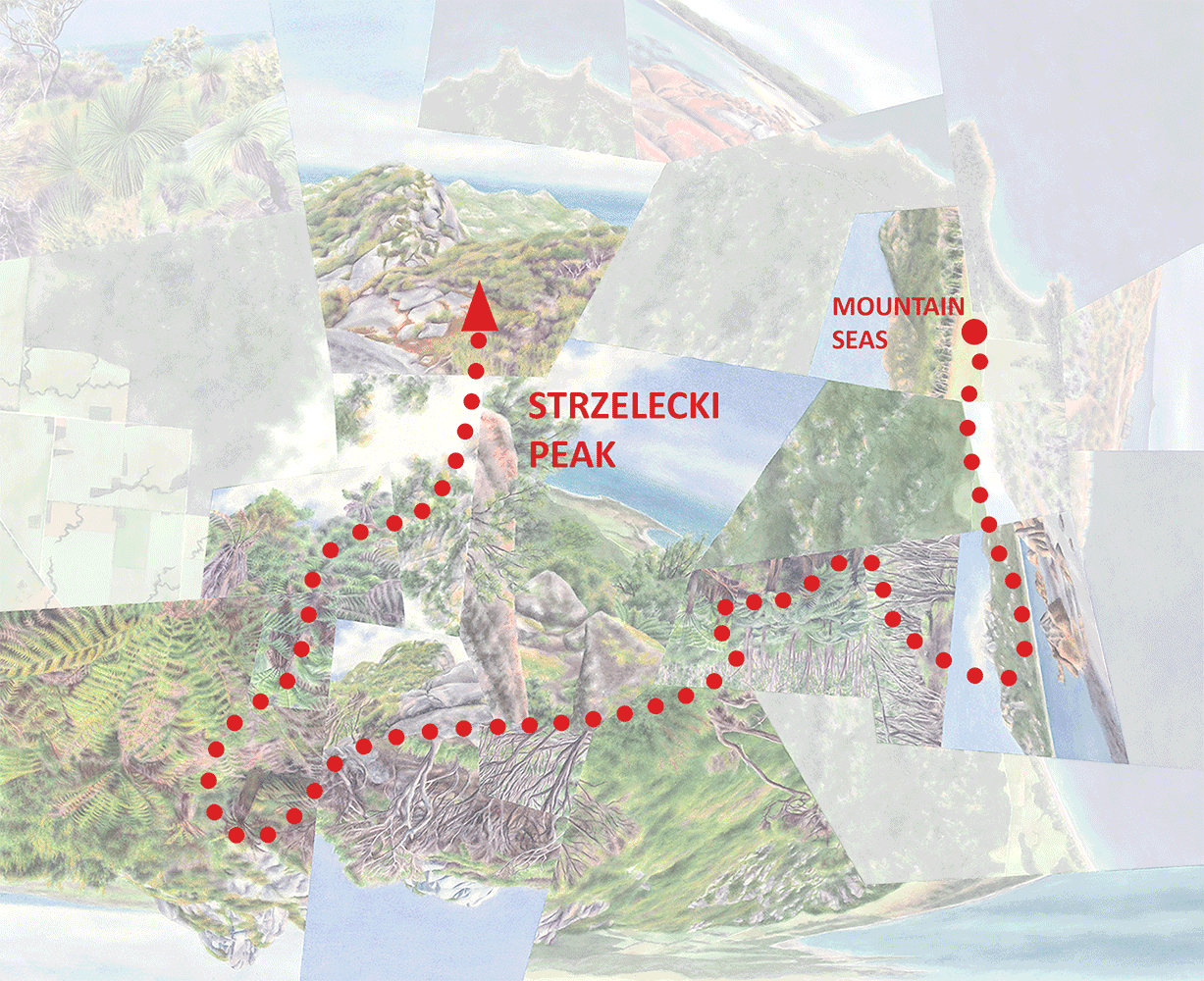My last few posts dealt with representations of real islands (two in the Galápagos and two in the Canaries) idealized to varying degrees; these next few will look at islands that are completely invented, based on pieces of real places. I’ve been creating fewer of these imaginary worldviews recently, partly because of an increased conservation-oriented message and partly because I find it a more exciting challenge to integrate a locale’s multiple facets in a way that corresponds to my actual experience of how they relate to one another. But my fractured style began (in photomontage) with imaginary places, and I expect I’ll cycle back there every so often.
Though the following works aren’t inspired by individual sites, they do each draw from particular regions or locales, and I’ve categorized them that way below.
The Kimberley, Australia
The first two worldviews are based on parts of the Kimberley region of northwest Australia that I didn’t visit but wish I had; so, the sites they depict are imaginary in that they’re cobbled together from my experiences of nearby places. But they’re also imaginary because the real places aren’t actually islands. As I’ve done in other instances, I’ve surrounded them by water in order to accentuate the sense of distinctiveness that I find empowering with all small islands, real or not.
The interior of The Kimberley is characterized by arid mountains and grasslands, broken by the occasional palm-filled gorge or oasis. The most iconic area is probably the Bungle Bungles (in Purnululu National Park)—sandstone formations described as “beehive” due to their weathered, rounded forms and colorful striations. I arrived in the area in mid-October just as tours were closing down due to the hot weather, but luckily I decided to splurge on a scenic flight.
Airplane view of the Bungle Bungles.
Tiger Island integrates the beehive landforms with an interior palm oasis and “coastal” grasslands filled with baobabs. (Technically I’ve taken another liberty with the baobabs, since they don’t grow in the Bungles themselves.)
Australia’s native baobab, Adansonia gregorii, near Kununurra, Western Australia.
Livistona victoriae in El Questro Gorge near Kununurra.
Tiger Island, watercolor on paper, 16”x16.”
(You may remember an earlier work I’ve posted on, Hidden Valley, that was also inspired by the geology and botany of The Kimberley but with an urban adjacency. The landforms in Hidden Valley National Park, right next to the town of Kununurra, are reminiscent of the Bungle Bungles but their forms and colors don’t reach the same level of “refinement.”)
The coastline of The Kimberley, at least in the area that I visited around the town of Broome, incorporates mangroves and mudflats, sparkling white beaches, and a type of tropical dry forest known as pindan on intensely red clay. It’s also a prime area for pearl farming and processing, particularly around Cape Leveque a few hours north of Broome. I turned down the option of going there, since the tour seemed to focus on pearls rather than the natural environment, but later regretted it since the landscape I picture it having I wasn’t able to find anywhere else on my own. I could very well have been playing it up in my head, but in any case the watercolors later allowed me to “experience” an even more ideal version of what I imagine I missed in real life. The resulting Pearl Islands envisions the place with the qualities of a pearl—white (sand), pristine, precious. And baobabs can look a little glossy in the right light.
Mangrove in mudflats south of Broome, Western Australia. The red in the foreground is typical of the coastal regions’s soil.
Pandanus, a genus only distantly related to palms, in Keep River National Park near Kununurra.
Pearl Islands, watercolor on paper, 15”x20.”
More of these to come! I’ll end this post with a reminder about Fractal Plein, the current Hang Art exhibition that I’m sharing with Debbie O’Brien showcasing our unique interpretations of place, space, and memory. It runs until March 22 with Artist Reception this coming Saturday. Details below!
Darren






















